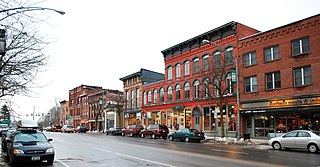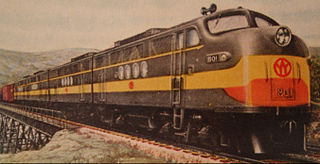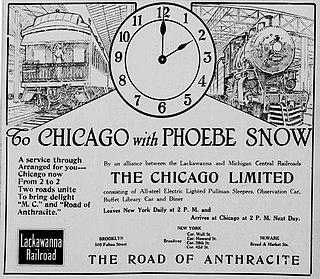Alexandria Bay is a village in Jefferson County, New York, United States, within the town of Alexandria. It is located in the Thousand Islands region of northern New York. The population of the village was 1,078 at the 2010 United States Census. It lies near the Thousand Islands Border Crossing of Canada and the United States.

Canton is a town in St. Lawrence County, New York. The population was 11,638 at the time of the 2020 census. The town contains two villages: one also named Canton, the other named Rensselaer Falls. The town is named after the great port of Canton in China. Canton is the home of St. Lawrence University and the State University of New York at Canton. The Canton Central School District is based in the village of Canton.

Massena is a town in St. Lawrence County, New York, United States. Massena is along the county's northern border, just south of the St. Lawrence River and the Three Nations Crossing of the Canada–United States border. The population was 12,433 at the 2020 census. The town of Massena contains a village also named Massena.

Potsdam is a town in St. Lawrence County, New York, United States. The town population was 14,901 at the 2020 census. The ZIP Code is 13676. When SUNY Potsdam and Clarkson University are in session, the population increases by approximately 8,000 students. The town is named after the city of Potsdam in Germany. The Town of Potsdam also contains a village named Potsdam. Potsdam is centrally located within the county and northeast of Canton, the county seat.

The New York Central Railroad was a railroad primarily operating in the Great Lakes and Mid-Atlantic regions of the United States. The railroad primarily connected greater New York and Boston in the east with Chicago and St. Louis in the Midwest, along with the intermediate cities of Albany, Buffalo, Cleveland, Cincinnati, Detroit, and Syracuse. New York Central was headquartered in New York City's New York Central Building, adjacent to its largest station, Grand Central Terminal.

The Michigan Central Railroad was originally incorporated in 1846 to establish rail service between Detroit, Michigan, and St. Joseph, Michigan. The railroad later operated in the states of Michigan, Indiana, and Illinois in the United States and the province of Ontario in Canada. After about 1867 the railroad was controlled by the New York Central Railroad, which later became part of Penn Central and then Conrail. After the 1998 Conrail breakup, Norfolk Southern Railway now owns much of the former Michigan Central trackage.
The Ontario Midland Railroad is an American Class III railroad company operating in western New York.
The Auburn and Syracuse Railroad was incorporated on May 1, 1834, to provide easy access between Syracuse, New York, and the Erie Canal. Construction was begun in 1835, but was delayed during the Panic of 1837. Although the economic downturn lingered until 1843, the railroad was completed by January 1838.

The New York, Ontario and Western Railway, more commonly known as the O&W or NYO&W, was a regional railroad with origins in 1868, lasting until March 29, 1957, after which it was ordered liquidated by a US bankruptcy judge. It was the first notable U.S. railroad with its mainline entirely abandoned.
The Lake Ontario Shore Railroad (LOSRR) was a short-lived common carrier railroad in New York that was absorbed by the Rome, Watertown and Ogdensburg Railroad.

The Empire State Express was one of the named passenger trains and onetime flagship of the New York Central & Hudson River Railroad. On September 14, 1891 it covered the 436 miles (702 kilometers) between New York City and Buffalo in 7 hours and 6 minutes, averaging 61.4 miles-per-hour (98.8 km/h), with a top speed of 82 mph (132 km/h).
The Charlotte Running Track, locally known as the Charlotte Runner or the Charlotte Branch, is a CSX Transportation-controlled branch line located in Rochester, New York. The track is roughly 9 miles (14 km) in length, beginning at control point 373 on CSX's Rochester Subdivision and snaking north through the residential and industrial sections of Rochester's west side before turning to the west in Charlotte onto what was the Hojack Line, terminating just to the west of Rochester Gas and Electric's Russell Power Plant in Greece.
The St. Lawrence Subdivision is a railroad line owned by CSX Transportation in the U.S. state of New York. The line runs from Syracuse, New York, north to Massena, New York, along a former New York Central Railroad line. At its south end, it meets the Syracuse Terminal Subdivision; its north end is at the south end of the Montreal Subdivision. Along the way it junctions with the Fulton Subdivision at Woodard, New York,.

Thendara station is the Adirondack Scenic Railroad's longest-duration northern terminus, and is near Thendara, New York. It is served by trains heading south to Utica beginning around the month of May each year. Trains continue along the 57-mile route along the Moose River in Adirondack Park. In the Winter, the right-of-way is used as a major snowmobile trail in the area after trains stop running in October. The resort village of Old Forge is 1.9 miles northeast of Thendara.
The Syracuse, Phoenix and Oswego Railroad was chartered on November 29, 1871, and had a route from Woodard, located north of Syracuse, New York, to Fulton, New York, a distance of 17.11 miles (27.54 km). They merged with the Syracuse Northwestern Railroad on June 10, 1875, and incorporated as Syracuse, Phoenix and Oswego Railway on February 16, 1885.
The Syracuse Northwestern Railroad was established in 1874 to construct a railroad from Woodard to Haymarket Square in Syracuse, New York. The company was consolidated under the Syracuse, Phoenix and Oswego Railroad in 1875 and was sold under a judgement in 1885 under the name Syracuse, Phoenix and Oswego Railway.

The Chicago Limited was a train running from Hoboken, New Jersey to Chicago, Illinois run by the Lackawanna Railroad and west of Buffalo connecting with the Michigan Central Railroad's Wolverine, taking a route through Southwestern Ontario. The train left New York at 2 pm and would arrive in Chicago at 2 pm the next day. The Wabash Railroad's #1-11 hitched with the train for coach and sleeper service that veered from the Michigan Central route from Detroit westward. It took the Wabash's most southernly route through Montpelier, Ohio.
Philadelphia is a town in Jefferson County, New York, United States. The population was 1,947 at the 2010 census, down from 2,140 in 2000.
The Wolverine was an international night train that twice crossed the Canada–United States border, going from New York City to Chicago. This New York Central Railroad train went northwest of Buffalo, New York, into Canada, traveled over Michigan Central Railroad tracks, through Windsor, Ontario, reentering the United States, through Detroit's Michigan Central Station, and on to Chicago. At the post-World War II peak of long-distance named trains, there were three other New York Central trains making this unusual itinerary through Southwestern Ontario. In the late 1960s, this was the last remaining train taking this route, failing to survive into the Penn Central era. The name resurfaced on the truncated Detroit–Chicago route with Amtrak's Wolverine.












